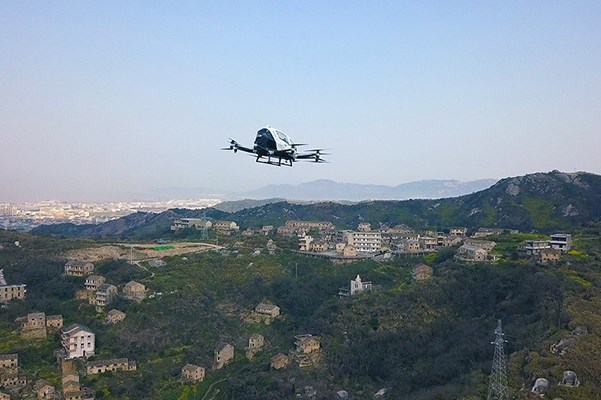China's EHang wins approval to use autonomous aerial vehicles for air logistics
The approval from the Civil Aviation Administration of China enables commercial operation of the EHang 216 passenger-grade plane for cargo transport.

Pilot operation of EHang 216 in Taizhou, China. Source | EHang
EHang Holdings Ltd. (Guangzhou, China), an autonomous aerial vehicle (AAV) technology platform company, reported on May 27 that it has obtained its commercial pilot operation approval from the Civil Aviation Administration of China (CAAC) to use EHang 216 passenger-grade AAVs for air logistic purposes. EHang says this makes them the world’s first AAV company approved by a national aviation authority to carry out commercial pilot operation for the category of 150-kilogram-plus heavy-lift air logistics uses.
With this approval, trial air logistics services will use the EHang 216 to transport cargo between ground and hilltop and between shore and islands at a customer site in Taizhou. Further, the company plans to gradually expand the aerial vehicle to other sites in China as it accumulates operational data and experience. EHang says that, as a member of the CAAC Special Expert Taskforce, its accumulated flight trials and tests have contributed significant experience to the CAAC to further develop and evolve regulations and standards related to passenger-grade AAVs.
This approval was granted based on the Pilot Operation Rules (Interim) for Specific Unmanned Aircraft promulgated by the CAAC in February 2019 for different categories of specific unmanned aircraft, including passenger-grade AAVs. It is a regulation for which the CAAC applied the Specific Operation Risk Assessment (SORA) framework of the Joint Authorities for Rulemaking of Unmanned Systems (JARUS), a group of experts from the national aviation authorities comprised of 61 countries, including China, the U.S., the European Aviation Safety Agency (EASA) and The European Organization for the Safety of Air Navigation (EUROCONTROL).
“This approval is of great significance,” says EHang founder, chairman and CEO Hu Huazhi. “For EHang, it enables us to accelerate the commercialization of AAV technology and air mobility solutions for logistics. It also lays a foundation for regulators around the world to jointly explore and establish a coordinated, supportive and sustainable regulatory environment. This will benefit the long-term development of urban air mobility [UAM] applications.”
Air logistics is an essential UAM application with huge market potential. According to investment banking company Morgan Stanley (New York, NY, U.S.), the global UAM market size could reach $1.5 trillion by 2040. Air logistics is expected to be one of the initial applications for commercialization.
Related Content
-
Composites opportunities in eVTOLs
As eVTOL OEMs seek to advance program certification, production scale-up and lightweighting, AAM’s penetration into the composites market is moving on an upward trajectory.
-
Update: THOR project for industrialized, recyclable thermoplastic composite tanks for hydrogen storage
A look into the tape/liner materials, LATW/recycling processes, design software and new equipment toward commercialization of Type 4.5 tanks.
-
Collins Aerospace to lead COCOLIH2T project
Project for thermoplastic composite liquid hydrogen tanks aims for two demonstrators and TRL 4 by 2025.















